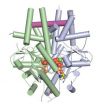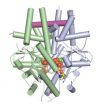(Press-News.org) The molecular complex that guides an important class of proteins to correct locations in cell membranes does so by forming a dimeric structure with a protective pocket, report scientists from the University of Chicago in Science on Mar. 5. This structure shields tail-anchored membrane proteins - which have roles in a wide variety of cellular functions from neurotransmitter release to insulin production - from harmful aggregation or misfolding as they move through the inner environment of a cell. The findings clarify the mechanism behind a fundamental biological process.
"The cell is able to shield tail-anchored proteins and get them to the right membrane at the right time through this two-subunit complex," said study co-senior author Robert Keenan, PhD, associate professor of biochemistry and molecular biophysics at the University of Chicago. "The simple analogy is that it's like a hot dog bun. It presents a large groove that accommodates the transmembrane region of the protein that's being targeted."
Membrane proteins are involved in a number of essential cellular functions such as signaling, catalyzing chemical reactions, and nutrient and ion transport. These proteins contain hydrophobic regions that allow them to be embedded in the hydrophobic lipid bilayer of cell membranes. During protein synthesis, which takes place inside the aqueous environment of a cell, emerging hydrophobic regions are predisposed toward clumping together in order to avoid water. As aggregation can be harmful, protective mechanisms immediately shield these regions as they emerge and then chaperone proteins to the membrane.
Unlike the majority of membrane proteins, tail-anchored proteins contain only one hydrophobic region that is usually the last to be synthesized. Because of this, the coordination of several molecular factors - together comprising the GET ('guided entry of tail-anchored proteins') pathway - are required to prevent tail-anchored proteins from aggregating.
The key component of this pathway is a targeting factor known as Get3, which captures and shields the hydrophobic region of tail-anchored proteins. The mechanism by which Get3 performs its protective function has been debated, leaving the study of the entire pathway in flux. Previous studies have argued that four molecules of Get3 combine to form a tetrameric complex that encase its cargo. But other studies, including ones from Keenan and co-author Ramanujan Hedge, PhD, of the Medical Research Council in Cambridge, have pointed to a dimeric complex involving only two subunits of Get3.
To resolve this question, the team, led by Agnieszka Mateja, PhD, postdoctoral fellow at the University of Chicago, first assembled Get3-substrate complexes in the laboratory. Using purified components to mimic physiological conditions, they found dimeric structures. Get3 has been shown to form dimers when linked to ATP, but Get3 also naturally degrades ATP over time, which likely led to previous observations of a tetrameric Get3-substrate complexes under non-physiological conditions. When the researchers expressed a tail-anchored protein in bacteria with a modified version of Get3 that was unable to degrade ATP, only dimeric complexes were formed.
To visualize the physiologically-relevant structure, the researchers used protein crystallization to study Get3 while it was holding a hydrophobic tail-anchored protein. In collaboration with Tony Kossiakoff, PhD, professor of biochemistry and molecular biophysics at the University of Chicago, the team designed synthetic antibody fragments that bound to specific parts of the Get3 dimer. These antibodies facilitated packing of Get3 and the substrate into the crystal. Analyzing this complex atom by atom, the team found that Get3 functioned exactly as they had predicted - with two Get3 subunits protecting the tail-anchored protein in a large hydrophobic groove.
"There was a lot of painstaking engineering that went into this, but ultimately we defined the structure of the physiologic complex," Keenan said. "It's a very important biological pathway, a hard technical problem, and now only the second instance where we have a glimpse of how a hydrophobic transmembrane protein binds to one of its targeting factors. This is a fundamental insight into how a cell works."
With the structure solved and the Get3 protective mechanism clarified, Keenan and his team are now investigating the mechanism of other steps in the GET pathway.
"The mechanistic details of the GET pathway are different if you assume a dimer model or a tetramer model," Keenan said. "By demonstrating that the physiologically relevant targeting complex is dimeric, we get a relatively simple, elegant working model. It really clarifies thinking in this field."
INFORMATION:
The study, "Structure of the Get3 targeting factor in complex with its membrane protein cargo," was supported by the National Institutes of Health, the US Department of Energy, the UK Medical Research Council and the Chicago Biomedical Consortium. Additional authors include Marcin Paduch, Hsin-Yang Chang, Anna Szydlowska, and Ramanujan S.Hegde. END
Dr. Anne Steinemann, Professor of Civil Engineering, and the Chair of Sustainable Cities, from the Department of Infrastructure Engineering, Melbourne School of Engineering, is a world expert on environmental pollutants, air quality, and health effects.
Professor Steinemann investigated and compared volatile organic compounds (VOCs) emitted from 37 different products, such as air fresheners, cleaning products, laundry supplies, and personal care products, including those with certifications and claims of 'green' and 'organic'. Both fragranced and fragrance-free products ...
New York City's eighth graders are anxiously waiting to find out which high school they'll be attending in the fall. Six percent of students will end up at one of the city's eight specialized high schools, known for their elite academics--and controversy around their lack of diversity. Female and, most starkly, Black and Latino students are all underrepresented at the schools.
A new report from the Research Alliance for New York City Schools examines students' pathways from middle school to matriculation at a specialized high school, and simulates the effects of various ...
Nanoparticles are extremely small particles that can be modified for a variety of uses in the medical field. For example, nanoparticles can be engineered to be able to transport medicines specifically to the disease site while not interfering with healthy body parts.
Selective drug transport verified in human tissue for the first time
The Munich scientists have developed nanocarriers that only release the carried drugs in lung tumour areas. The team headed by Silke Meiners, Oliver Eickelberg and Sabine van Rijt from the Comprehensive Pneumology Center (HMGU), working ...
The use of psychedelics, such as LSD and magic mushrooms, does not increase a person's risk of developing mental health problems, according to an analysis of information from more than 135,000 randomly chosen people, including 19,000 people who had used psychedelics. The results are published today in Journal of Psychopharmacology.
Nature and Lancet
Nature published a news item on this research yesterday, March 4: http://www.nature.com/news/no-link-found-between-psychedelics-and-psychosis-1.16968 Lancet Psychiatry will publish a companion letter to this study by Teri ...
A study conducted at The University of Manchester's Health eResearch Centre found that there was no link between a £10 billion pay-for-performance incentive scheme aimed at GP's and a reduction in premature deaths.
The Quality and Outcomes Framework (QOF), was first introduced in 2004 and links up to 25% of a GP's income to their performance in over 100 quality indicators.
Many of these indicators cover the most common diseases including heart disease, diabetes and cancer and are in place to ensure that the proper preventative care is delivered to patients.
The ...
Older brains may be more similar to younger brains than previously thought.
In a new paper published in Human Brain Mapping, BBSRC-funded researchers at the University of Cambridge and Medical Research Council's Cognition and Brain Sciences Unit demonstrate that previously reported changes in the ageing brain using functional magnetic resonance imaging (fMRI) may be due to vascular (or blood vessels) changes, rather than changes in neuronal activity itself.
Given the large number of fMRI studies used to assess the ageing brain, this has important consequences for ...
WASHINGTON, D.C., March 5, 2015--Despite growing enthusiasm among educators and scholars about the potential of school-based executive function interventions to significantly increase student achievement, a federally funded meta-analysis of 25 years' worth of research finds no conclusive evidence that developing students' executive function skills leads to better academic performance, according to a new study published today in Review of Educational Research, a peer-reviewed journal of the American Educational Research Association.
VIDEO: Co-author Robin Jacob discusses ...
VTT Technical Research Centre of Finland Ltd has been the first to publish a scientific study on the successful generation of hybrid lager yeasts. For centuries the same few yeast strains have been used in the production of lager beer, in contrast to ale, whisky, wine and cider, for which there is a wide range of yeast strains available to produce different nuances of flavour. VTT has been developing hybrid lager yeasts so as to impart new flavour to the beer and accelerate the production process.
Traditionally, even very different tasting lagers have been produced using ...
Bethesda, MD (March 5, 2015) -- A better understanding of the stomach's immune response to Helicobater pylori (H. pylori) infection could lead to new therapies targeting damage in the stomach, report researchers in the March issue of Cellular and Molecular Gastroenterology and Hepatology, the basic science journal of the American Gastroenterological Association.
When H. pylori infection is present, the alarmin Interleukin (IL)-33 is a critical messenger that triggers changes necessary for coping with the injuries caused by the infection. Specifically, it actives an ...
San Diego, CA--Prenatal exposure to low doses of the environmental contaminants polychlorinated biphenyls, or PCBs, change the developing brain in an area involved in metabolism, and some effects are apparent even two generations later, a new study finds. Performed in rats, the research will be presented Friday at the Endocrine Society's 97th annual meeting in San Diego.
Hereditary effects included increased body weight, but only in descendants of females--and not males--exposed to PCBs in the womb, said study co-author Andrea Gore, PhD, professor at the University of ...


